The issues.
With such large sums of money being involved, the naming
of medals has attracted over the years the attention of the faker, the forger,
the unscrupulous, and the plain criminal (not to mention the well intentioned
innocent!). With the prices medals achieve today it is absolutely imperative that
the new collector gets to grips with the naming issues to make sure he or she does not
end up out of pocket, or "ripped off" to use the modern phrase. Below are
the important issues as I see them. Following that, it is my intention to build
a database of British medals with images of naming styles, links to these
will be in a table at the bottom of the page. This will be gradual as time permits,
so check back occasionally.
(Also see:
Medals of the Regiments for qualification by regiment
for Infantry and Cavalry units.) |
| |
|
1. Correctly, or officially named
There is frequently one main style of naming to a
particular medal issue. Unfortunately there are about as many exceptions to this
generalisation as there are medals issues! - and this is also true of the great
war medals due to the vast numbers issued and the number of different
contractors involved in the naming. The term "officially named", can be somewhat
misleading, it
doesn't mean the "government style of naming" but it could mean "the style
accepted in the medal collecting fraternity as a style frequently encountered
and accepted as correct and as issued" |
| |
|
2. Officially corrected
Everyone makes mistakes. When an error was made during the impressing or engraving
process, the medal was not discarded, instead the erroneous character(s)
was mechanically removed (erased, filed off) and the area stamped again with the
correct character(s) |
|
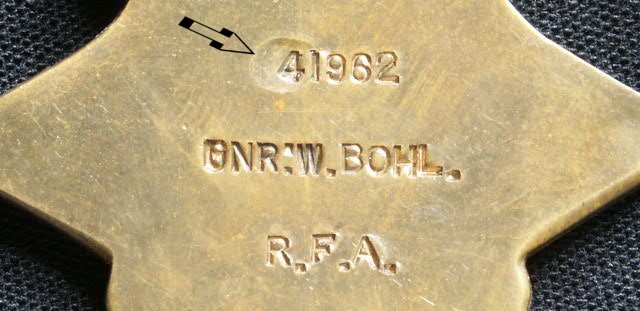 |
| |
|
Above,
First World War 1914-15 Star, showing an official correction to the first digit
of the service number.
Removal of the error has produce a smooth concave
depression into which has been stamped the correct
number: "4". Faint traces of
the original erroneous number remain. |
| |
|
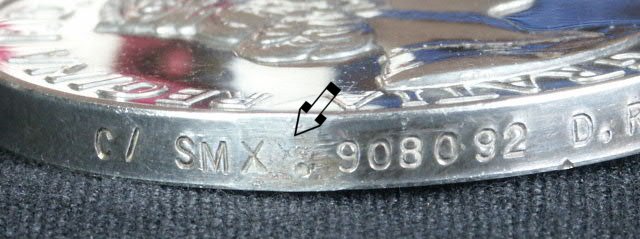 |
| |
|
Above: EIIR Navy General Service 1915-1962, bar "Near East". To C/SMX.
908092 D. R. Wood. L.E.M. R.N.
The error coincides with the
last letter of the number prefix and the full stop. A ghost "X" is just visible
(arrowed). |
| |
3. Officially renamed.
As above but applicable to the whole of the naming, that is the medal shows
(a) mechanical removal of metal along the whole of the naming generally
coinciding with the renaming , and /or (b) measuring with a micrometer (in the
case of circular medals) the disk is found to be out of true, and hence metal is
assumed to have has been removed . |
| |
|
4. Late issue and wrong style.
Service people who miss out on the initial issue of a medal can do so for
several reasons, e.g. later clarification of eligibility rules can reveal more
recipients, individuals are missed off the medal rolls, personally realise they
are eligible and make a successful claim at a later date. As time moves on
naming styles come and go, and late issues by nature have a feature revealing
them as such, not just necessarily a later naming style but perhaps a different
suspender or they are struck on a thicker (or thinner) flan than the bulk of the
issue. Another point to note is that official but atypically named medals can be
duplicate or replacement issues and not marked as such. |
| |
5. Erased
Medals can commonly be found with all or some of the details erased. I
suppose this has been mainly done by in the past to create a "blank" replacement
medal for a recipient who is no longer in possession of his medal for whatever
reason (originals lost, stolen, sold when fallen on hard times, etc.). Although
there is another reason - groups can be found (not uncommonly) with an erased
medal the recipient was not entitled to- maybe he failed the criteria for award
by a thin margin of days or geographic placement and decides to "correct" the
situation himself. whatever the reason, generally erasure has a serious affect
on desirability (and hence price).
|
|
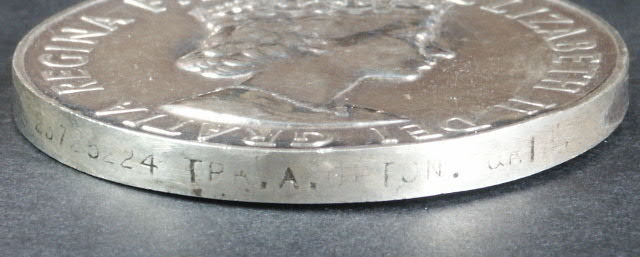 |
| |
|
Above: an erased Campaign Service Medal, or I should say nearly erased, as the
individual responsible
has not done a very "good" job, details are still readable , in this case
"23725224 Tpr. A. Upton Q.R.I.H"
(Queens Royal Irish Hussars).
|
| |
|
6. Renamed
The next step from 4. above. The erased medal is re-engraved / impressed
with the recipients details, and hey presto! he has his medal back. Not in the
eyes of the collector though, and as above, the desirability is seriously
depressed. Remember the important distinction between "officially renamed"
and plain old "renamed" renamed is generally amateurish and uneven,
probably done by the village watchmaker or similar (our well intentioned
innocent ) for a shilling and sixpence for our Private Tommy Atkins.
|
| |
7. Named to deceive.
"Oh, the horror,.. the horror..." (Colonel Walter E. Kurtz,
"Apocalypse
Now") Yes the practice exists unfortunately. Probably the best way to keep up to
date with the faker and forgers activities is to join an organisation like the
Orders and Medals Research
Society whose quarterly publication "The Journal" runs occasional articles
on fakes and forgeries - for instance I have before me their article on recent
fraudulent naming of officially issued unnamed WW1 campaign medals
-fraudulently named to South African Officers- and another article on fake
Waterloo medals. -essential reading. |
| |
8. Duplicate and Replacement Issues.
First thing to mention is that identical named medals exist. Double issued
in error, unmarked duplicates/replacements who knows. For example I recently had
two 1914-15 Stars identical including the naming, with no reference to
duplicates or the like on the medal roll or index card. Of course duplicates are
a lot easier to detect when marked as such. Medals can be found stamped
"REPLACEMENT", "DUPLICATE", "R", "D" .
Two replacement GVI General Service Medals are shown below. No chance of
mistaking the first for what it is , but the second could be missed due to the
single letter "R" being high up on the shoulder of the disk at about 2 o'clock.
|
|
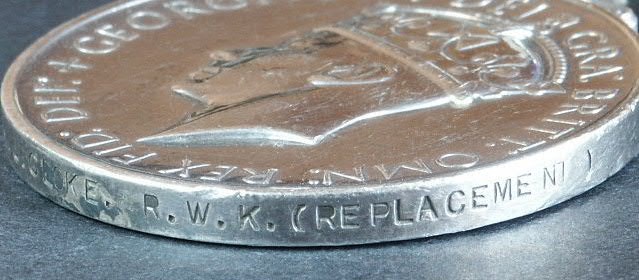 |
| |
|
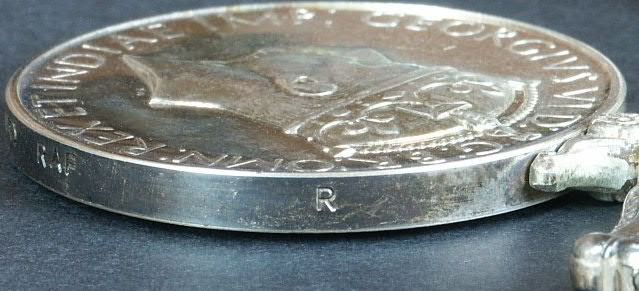 |
| |